ISS: SpaceX CRS-23 (International Space Station: SpaceX Commercial Resupply Service -23 Mission)
Non-EO
NASA
Mission complete
Quick facts
Overview
| Mission type | Non-EO |
| Agency | NASA |
| Mission status | Mission complete |
| Launch date | 29 Aug 2021 |
| End of life date | 01 Oct 2021 |
ISS: SpaceX CRS-23 (International Space Station: SpaceX Commercial Resupply Service -23 Mission)
Launch Experiments Mission Status References
Launch
The 23rd SpaceX cargo resupply services mission carrying scientific research and technology demonstrations to the International Space Station was launched on a Falcon 9 vehicle from Launch Complex 39A at the Kennedy Space Center at 3:14 a.m. (07:14 UTC) on 29 August 2021. The Dragon spacecraft will also deliver supplies and equipment for the international crew. 1)
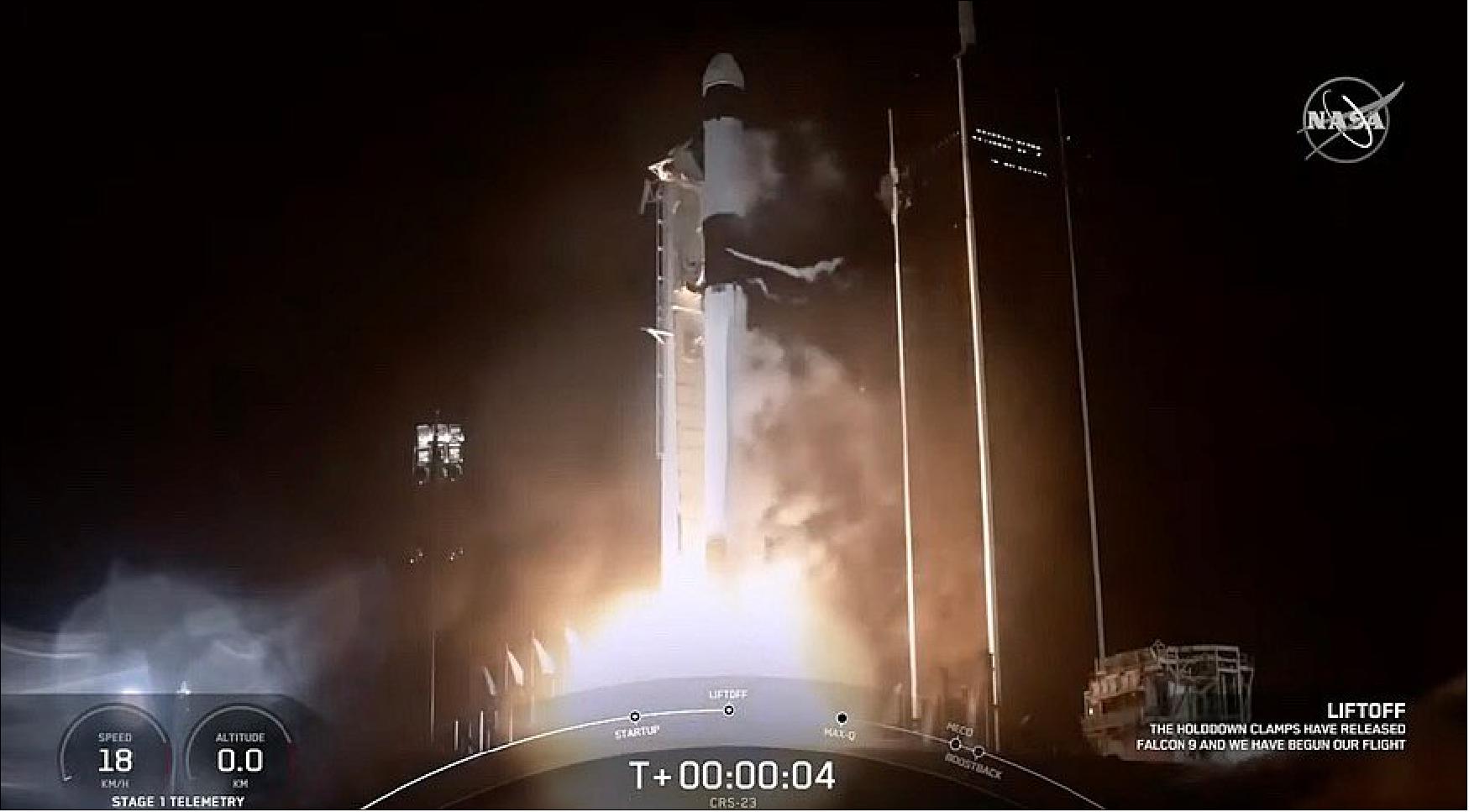
Orbit
Near circular orbit, altitude of ~ 400 km, inclination = 51.6º, period of~92 minutes.
The Dragon spacecraft separated from the rocket’s upper stage about 12 minutes after liftoff and is scheduled to dock with the station at about 11 a.m. Eastern Aug. 30 for an approximately one-month stay.
The launch was the first for a Falcon 9 since the June 30 launch of the Transporter-2 rideshare mission, the longest pause since a three-month gap between launches from August to November 2019. One reason for the hiatus was a delay in Starlink launches to equip those satellites with laser inter-satellite links; the majority of the Falcon 9 launches this year have been Starlink missions.
“We launch when our customers need us to launch,” Sarah Walker, director of Dragon mission management at SpaceX, said during a prelaunch briefing Aug. 27. She said the company took advantage of the gap to look for “small improvements” in launch operations. “But nothing major changed in terms of preparations for this launch.”
One more significant change is the use of a new SpaceX droneship, called “A Shortfall of Gravitas,” to serve as the landing pad for the Falcon 9 first stage. This droneship, the third in SpaceX’s fleet, features what Walker called “great upgrades,” including the capability to operate completely autonomously. On this launch, though, the droneship was accompanied by a tug, as with previous droneship missions.
It joins “Just Read the Instructions” for supporting launches from Cape Canaveral. “We needed a third vehicle to support the high launch cadence we’re seeing at SpaceX right now,” she said. The third droneship, “Of Course I Still Love You,” is now in California for upcoming launches from Vandenberg Space Force Base (VSFB).
The Dragon is carrying 2,207 kg of cargo, about half of which is research, from materials science to biology. Also on the spacecraft is a small robotic arm developed by Japanese company GITAI that will be tested in Nanoracks’s Bishop commercial airlock, as well as various hardware components for the station.
Unlike many previous Dragon cargo missions, there is no external cargo in the trunk section. Jennifer Scott Williams, manager of the applications client support office for the ISS program at NASA, said that “supply issues and other interruptions due to the pandemic” caused payloads intended to go in the trunk on this launch to slip to future missions. That includes a payload for the Defense Department’s Space Test Program, called STP-H7, which will now launch together with STP-H8 on the next cargo Dragon mission later this year.
This cargo Dragon previously flew the CRS-21 cargo mission in late 2020, and is the first of the upgraded cargo Dragons, introduced on the CRS-21 mission and based on the Crew Dragon spacecraft, to be reused. Walker said upgrades to the cargo Dragon allowed SpaceX to cut the time needed to refurbish the spacecraft to half or even a third of that needed for the first-generation cargo Dragons.
The Falcon 9 booster on this launch was on its fourth flight, having previously launched the Crew-1 and Crew-2 commercial crew missions and, most recently, the SXM-8 communications satellite.
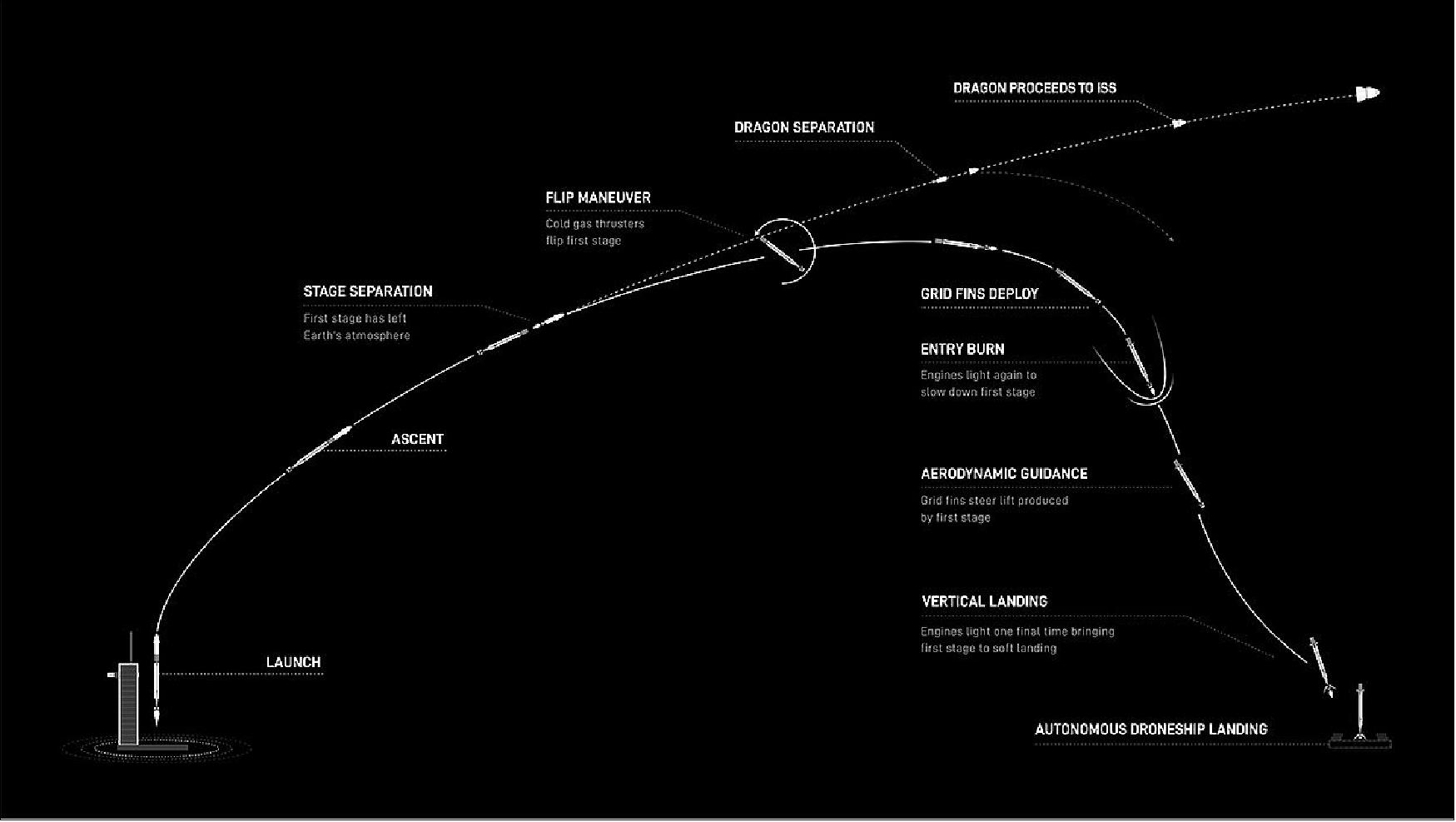
Experiments
Some Scientific Highlights
Experiments aboard include an investigation into protecting bone health with botanical byproducts, testing a way to monitor crew eye health, demonstrating improved dexterity of robots, exposing construction materials to the harsh environment of space, mitigating stress in plants, and more. 3)
Building Bone with Byproducts
READI FP (REducing Arthritis Dependent Inflammation First Phase) evaluates the effects of microgravity and space radiation on growth of bone tissue and tests whether bioactive metabolites, substances such as antioxidants formed when food is broken down, might protect bones during spaceflight. The metabolites tested come from vegetal extracts generated as waste products in wine production.
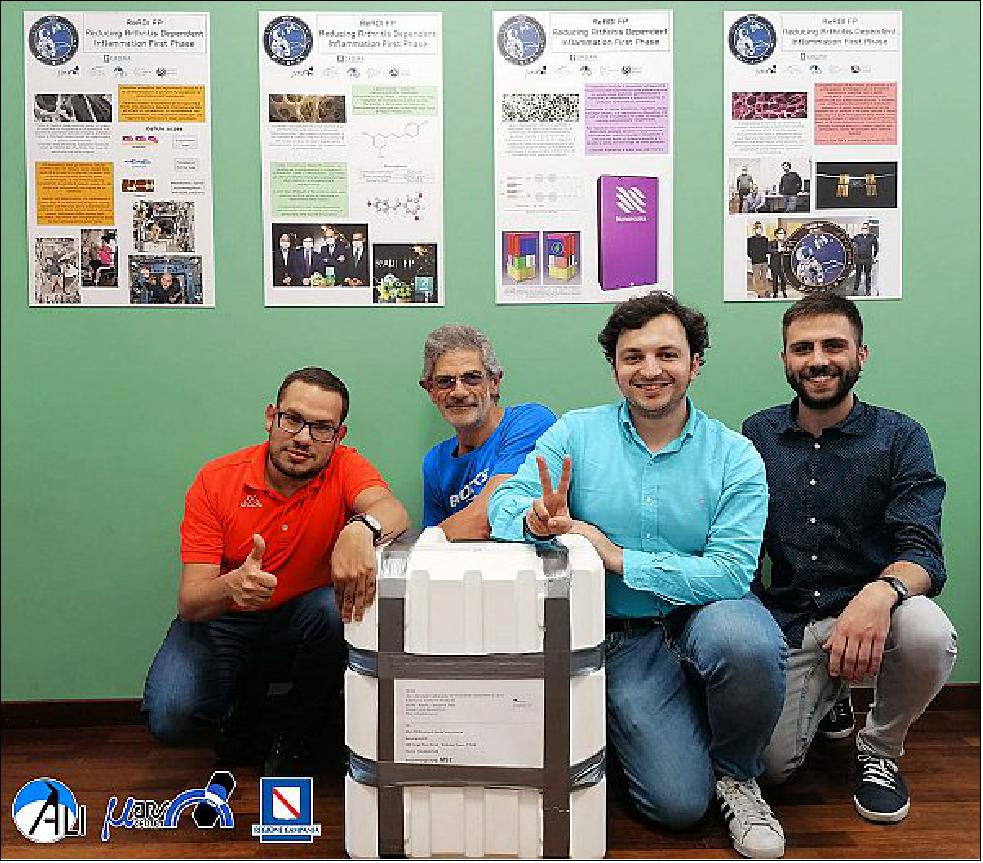
Protecting the health of crew members from the effects of microgravity is crucial for the success of future long-duration space missions. This study could improve understanding of the physical changes that cause bone loss and identify potential countermeasures. This insight also could contribute to prevention and treatment of bone loss on Earth, particularly in post-menopausal women. Sourcing metabolites from materials that otherwise would become waste is an additional benefit.
Keeping an Eye on Eyes
Retinal Diagnostics tests whether a small, light-based device can capture images of the retinas of astronauts to document progression of vision problems known as Space-Associated Neuro-Ocular Syndrome (SANS). The device uses a commercially available lens approved for routine clinical use and is lightweight, mobile, and noninvasive. Videos and images can be downlinked to test and train models for detecting common signs of SANS in astronauts. The investigation is sponsored by ESA (European Space Agency) with the German Aerospace Center (DLR) Institute of Space Medicine and European Astronaut Centre (EAC).
“SANS is present in over two-thirds of astronauts and thought to be associated with long duration (30 days or longer) exposure to microgravity,” said principal investigator Juergen Drescher of DLR. “Currently, visual problems that may manifest from SANS are mitigated by providing glasses or contact lenses to crew members. Multi-year missions to Mars may worsen these symptoms, and there is a need for a mobile device for retinal image diagnostics. While developed for space, this mobile technology has potential to provide diagnostics in remote and extreme environments on Earth at reduced cost. Mobile biomedical diagnostic devices such as these will likely emerge as both an enabler of human deep space exploration and a sustainable model for health care on Earth.”
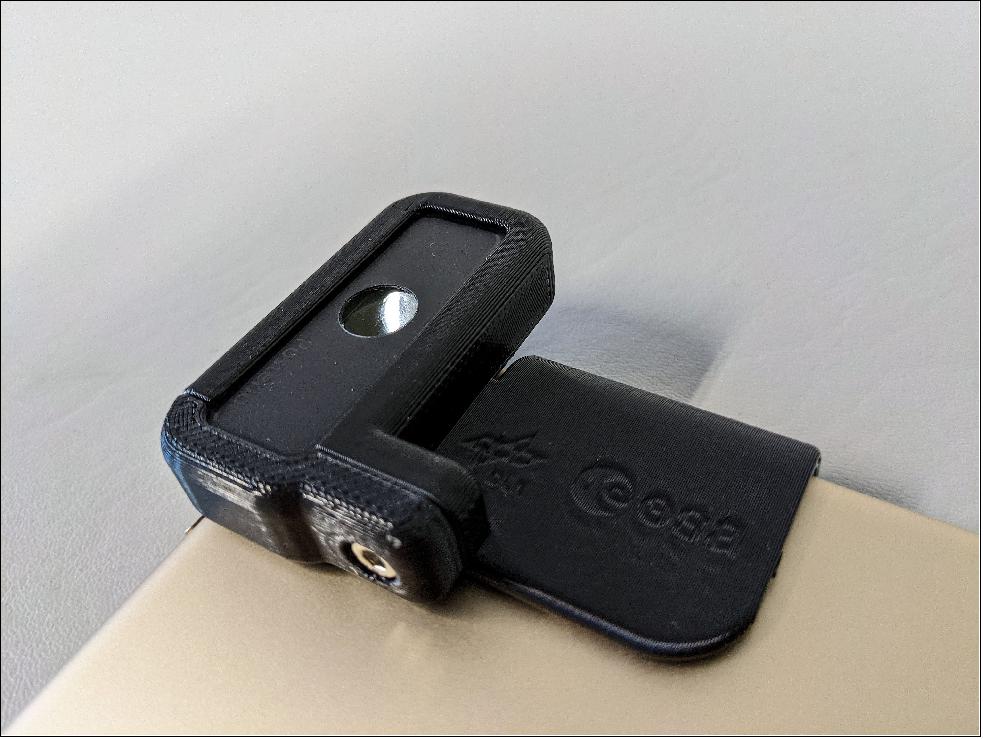
Robotic Helpers
Nanoracks-GITAI Robotic Arm demonstrates the versatility and dexterity in microgravity of a robot designed by GITAI Japan Inc. Results could support development of robotic labor to support crew activities and tasks, as well as servicing, assembly, and manufacturing tasks while in orbit. Robotic support could lower costs and improve crew safety by having robots take on tasks that could expose crew members to hazards. The technology also has applications in extreme and potentially dangerous environments on Earth, including disaster relief, deep-sea excavation, and servicing nuclear power plants. The experiment will be conducted under the pressurized environment inside the Bishop Airlock, the space station’s first commercial airlock.
“This technology demonstration is to show the world that the capabilities necessary for automation in space are finally available,” said company chief technology officer Toyotaka Kozuki. “It provides an inexpensive and safer source of labor in space, opening the door to the true commercialization of space.”

Putting Materials to the Test
MISSE-15 NASA (Materials International Space Station Experiment-15) is one of a series of MISSE investigations testing how the space environment affects the performance and durability of specific materials and components. These tests provide insights that support development of better materials for future spacecraft, spacesuits, planetary structures, and other components needed for space exploration. Testing materials in space has the potential to significantly speed up their development. Materials capable of standing up to space also have potential applications in harsh environments on Earth and for improved radiation protection, better solar cells, and more durable concrete. Alpha Space provides the MISSE-FF (Materials ISS Experiment Flight Facility) lab that hosts these investigations.
“MISSE-15 includes tests of concrete, spacecraft materials, fiberglass composites, thin-film solar cells, radiation protection materials, a micro-optical chip, 3D printed polymers, and more,” said MISSE project engineer Ian Karcher. “In addition, the availability of this platform for commercial technology development contributes to the ongoing commercialization of space and development of new space technologies.”
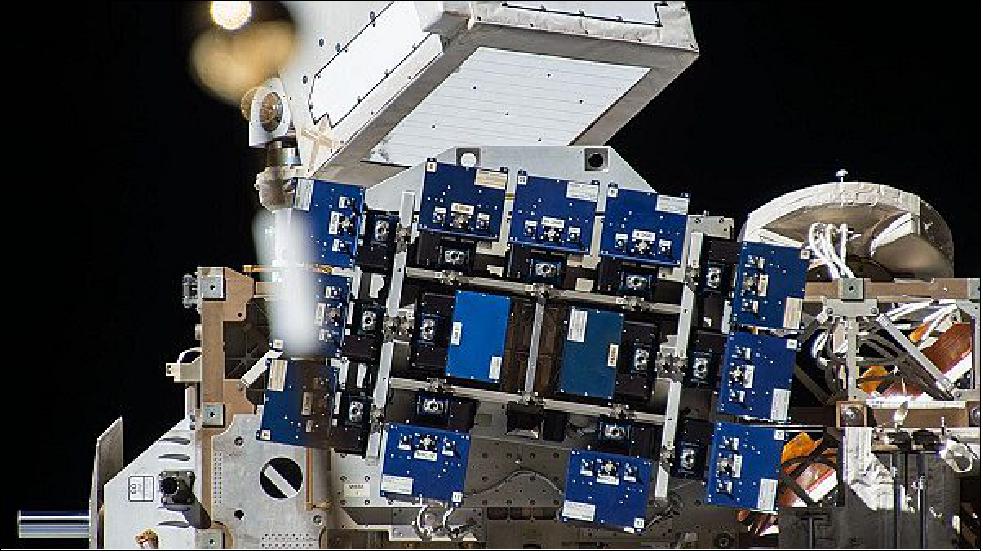
Helping Plants Deal with Stress
Plants grown under microgravity conditions typically display evidence of stress. APEX-08 (Advanced Plant EXperiment-08) examines the role of compounds known as polyamines in the response of thale cress to microgravity stress. Because expression of the genes involved in polyamine metabolism remain the same in space as on the ground, plants do not appear to use polyamines to respond to stress in microgravity. APEX-08 attempts to engineer a way for them to do so. Results could help identify key targets for genetic engineering of plants more suited to microgravity.
“On Earth, polyamines have been shown to contribute significantly to the mitigation of multiple environmental stresses in plants,” said principal investigator Patrick Masson, a professor at University of Wisconsin-Madison. “Altering the metabolism of a polyamine to mitigate the stress of microgravity could have an impact on our ability to use plants as key components of bioregenerative life support systems on long-term space exploration missions. It also may improve our understanding of the molecular mechanisms that allow plants to respond to general environmental stress on Earth, with impacts on agriculture, horticulture, and forestry.”
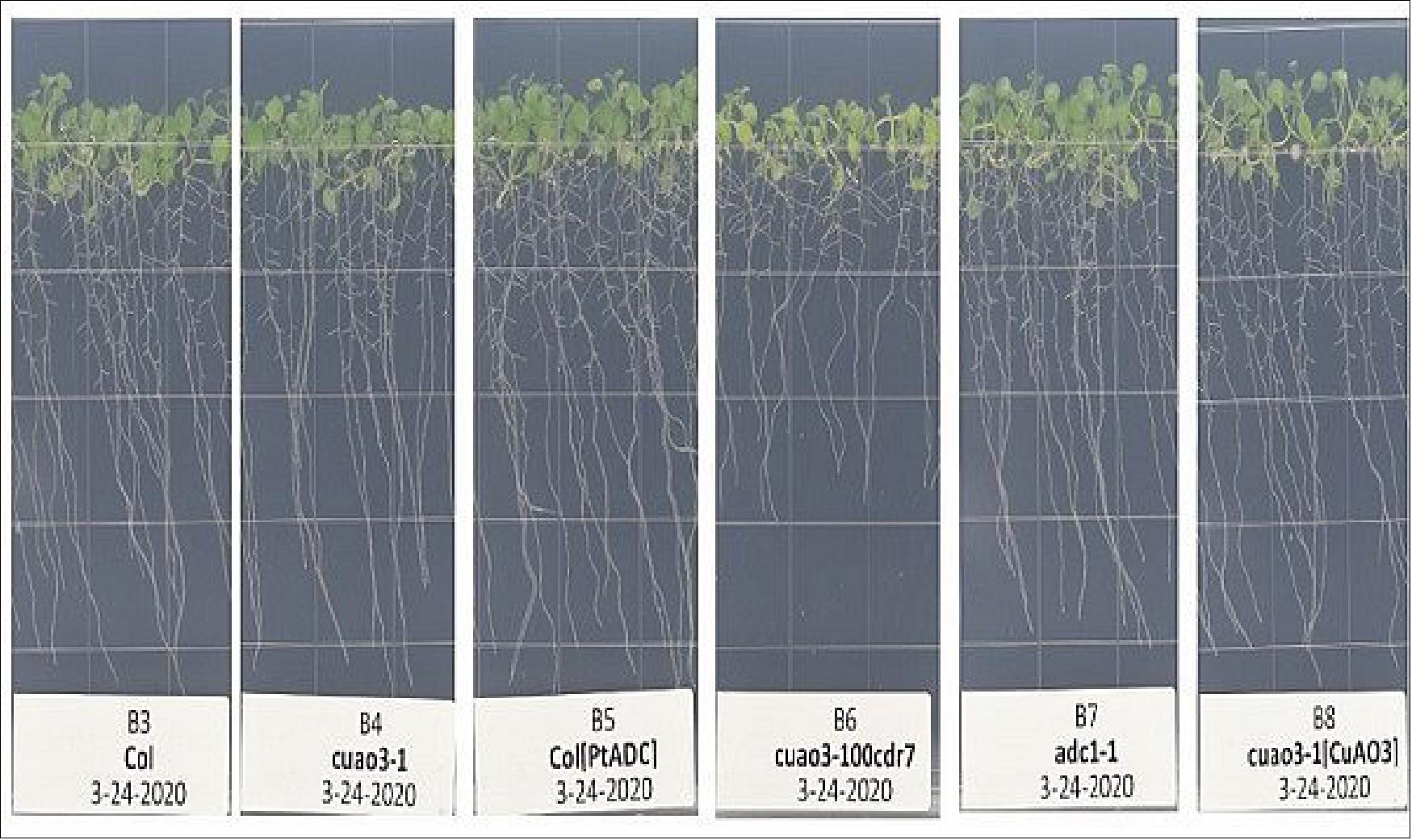
Easier Drug Delivery, Girl Scouts Send Science to Space
The Faraday Research Facility is a multipurpose research facility that uses the space station’s EXPRESS racks. On this first flight, the facility hosts a Houston Methodist Research Institute experiment and two STEM collaborations, including “Making Space for Girls” with the Girl Scouts of Citrus Council.
“The ProXopS Faraday Research Facility, developed in partnership with L2 Solutions Inc., is designed to operate remotely and provide a controlled environment for power, command and control, telemetry responses, and safety assurance for microgravity experiments,” said Chad Brinkley, president of ProXopS LLC and L2 Solution Inc. “An added benefit with the facility is that experiments return to the ground for evaluation.”
Faraday-NICE tests an implantable, remote-controlled drug delivery system using sealed containers of saline solution as surrogate test subjects. The device could provide an alternative to bulky, cumbersome infusion pumps, a possible game changer for long-term management of chronic conditions on Earth. Potential problems with such pumps include high infection risk, electromechanical failures, and double dosing. NICE is minimally invasive, implantable, has no moving mechanical components, and does not require catheters. Remote-controlled drug delivery could increase patient compliance, especially for children, elderly, and disabled individuals.
Faraday-Girl Scouts places control experiments with a Girl Scout troop and provides students with images of the same experiments in space. The studies include plant growth, ant colonization, and the brine shrimp lifecycle.
Film and Cultures
• Samples of the Biofilms experiment are headed to the International Space Station on the SpaceX CR23 cargo resupply mission this weekend to help maintain astronaut and material safety in space. 4)
- A common piece of advice of the past 18 months has been to make sure you wash your hands thoroughly. This is because microorganisms are easily spread across common surfaces like door handles and light switches, and it is no less true in space. The Space Station is, after all, a lab as well as a home to astronauts. It is especially important to keep this environment safe for the long-term health of astronauts and equipment on board.
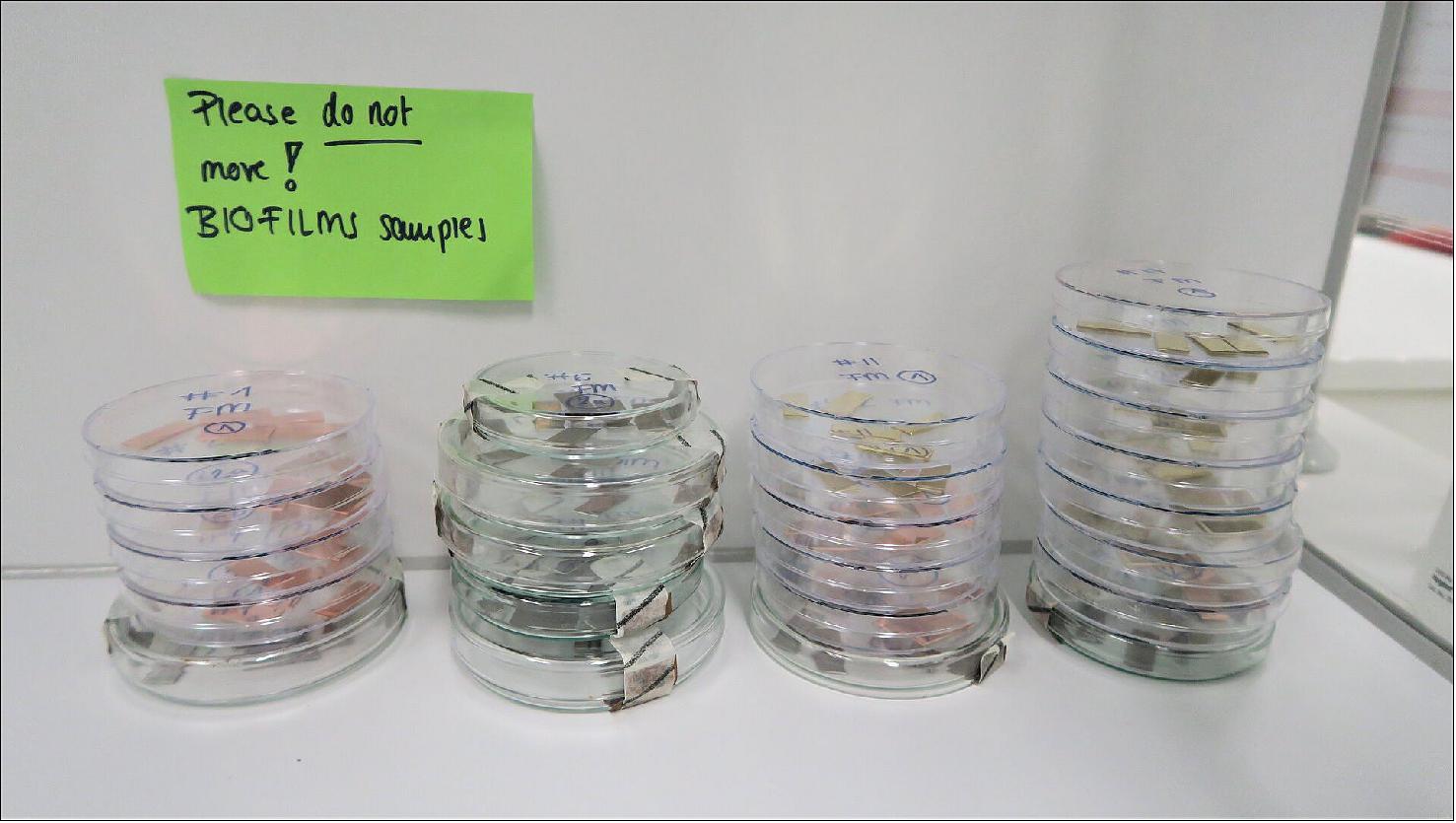
- Funded by ESA and developed by the Chair of Functional Materials at Saarland University and the Working Group for Aerospace Microbiology at German Aerospace Center DLR, Biofilms will test the antimicrobial properties of laser-structured metal surfaces such as steel, copper and brass under microgravity conditions.
- But what is biofilm? When growing on surfaces, bacteria can ooze a mixture of microbial structures such as proteins and lipids. The biofilm is what makes microbes resistant to antibiotics and disinfectants. Left to grow, biofilm can be hard to clean and can erode surfaces, especially metals.
- To combat microbial growth, Biofilms will test the growth of bacteria such as human skin-associated bacteria Staphylococcus capitis with a novel approach. The innovation of the experiment lies in the structured surfaces of common metals. Using Direct Laser Interference Patterning (DLIP) to add texture to the surfaces, researchers will study how well microbes grow (or not) on copper, metal and steel. Findings could help prevent microbial contamination in space.
- Researchers performed a dry run of the experiment on Earth and all parameters, including hardware provided by Keyser Italia, checked out. The experiment will soon take center stage in space, where 24 experiment cultures will grow in the European Columbus module of the Space Station.
3D Organoids in Space
• August 26, 2021: On this resupply flight, the Space Hub of the University of Zurich (UZH) and Airbus Defence and Space are bringing an experiment into space, which is intended to further advance the industrial production of human tissue in zero-gravity conditions. With this step, space could become a workshop for producing miniature human tissue for terrestrial use in research and medicine. Initial preparatory tests on the ISS 18 months ago were successful. 5)
- The process for the joint "3D Organoids in Space" project comes from Zurich scientists Oliver Ullrich and Cora Thiel, pioneers in research on how gravity influences human cells. Together with Airbus, they have developed the process to project maturity. The Airbus Innovations team led by project manager Julian Raatschen is developing the hardware and providing access to the ISS. From the idea to the first production test in space it took the project partners only three years to complete various test phases and highly competitive internal selection procedures. "We are the first to show that the path to production in space is feasible, not in theory, but in practice," says Oliver Ullrich.
Improving Drug Development and Reducing Animal Testing
- Oliver Ullrich, professor of anatomy at UZH, biologist Cora Thiel and Airbus are using microgravity in space to grow three-dimensional organ-like tissues - so-called organoids - from human adult stem cells. "On Earth, three-dimensional organoids cannot be produced without supporting skeletons because of gravity," Thiel explains. Such 3D organoids are of great interest to pharmaceutical companies: Toxicological studies could thus be carried out directly on human tissue without the need for animal models. Organoids grown from patient stem cells could also be used in the future as building blocks for tissue replacement therapy for damaged organs. This is because the number of donated organs is far from sufficient to meet the worldwide demand for thousands of donor organs.
3D Organoids Grown in Space
- The research conducted in March 2020, when 250 test tubes containing human stem cells spent a month on the ISS, was very successful: differentiated organ-like liver, bone and cartilage structures had developed as intended from the tissue stem cells in microgravity at an altitude of 400 km. In contrast, the cultures created on Earth, which were grown as controls under normal gravity conditions, showed no or only minimal cell differentiation.
Robustness and Viability
- In the current mission, tissue stem cells from two women and two men of different ages are being sent into space. In doing so, the researchers are testing how robust the method is when using cells of different biological variability. They expect production to be easier and more reliable in microgravity than using support structures to grow on Earth. "Currently, the focus is on production engineering issues and quality control." With regard to the envisaged commercialization, we now have to find out how long and in what quality we can keep the organoids grown in space in culture after their return to Earth," says Ullrich.
- "If successful, the technology can be further developed and brought to operational maturity. Airbus and the UZH Space Hub can thus make a further contribution to improving the quality of life on Earth through space-based solutions," says Airbus project manager Raatschen.
- The sample material will return to Earth at the beginning of October. First results are expected from November.
About the “3D Organoids in Space" Project
- The joint project started in 2018. The teams from the UZH Space Hub and Airbus Defence and Space submitted their proposal to an Airbus internal innovation and ideas competition to obtain basic funding and start initial research work. There, the project successfully prevailed alongside 500 other ideas.

Passenger Payload Missions on the CRS-23 Flight of SpaceX to the ISS
• AMBER IOD-3 (In Orbit Demonstration-3), a CubeSat of Horizon Space Technologies (UK), built by ÅAC Clyde Space to provide signal data for the country’s National Maritime Information Centre (NMIC). L3Harris Technologies is assisting with the payload’s development.
• Binar-1, a CubeSat, a team of students and engineers at Curtin University's Space Science and Technology Centre in West Australia developed the state-of-the-art Binar-1 CubeSat.
• CAPSat (Cool Annealing Payload Satellite), a CubeSat of UIUC (University of Illinois, Urbana Champaign) to perform quantum annealing experiments.
• CUAVA-1 (ARC Training Centre for CubeSats, UAVs & Their Applications), a 3U CubeSat, developed by the UNSW (University of New South Wales) based Centre for CubeSats and the University of Sydney. 7)
• PR-CuNaR2 (Puerto Rico CubeSat NanoRacks-2), a 3U CubeSat developed by students of the Inter-American University of Puerto Rico’s school of Engineering in Bayamón Campus - in cooperation with the Florida Space Institute and the Physics Department of the University of Central Florida (UCF).
• SPACE HAUC (Science Program Around Communications Engineering with High-Achieving Undergraduate Cadres), a 3U CubeSat (4 kg) of UMass (University of Massachusetts) at Lowell.
• Maya-3 and Maya-4, two 1U CubeSats of the University of the Philippines-Diliman and Kyushu Institute of Technology, Japan.
• OSCAR-QUBE (Optical Sensors based on CARbon materials: QUantum BElgium), a 1U CubeSat, built by students of Hasselt University, Belgium.
Mission Status
• August 31, 2021: The Expedition 65 crew is unpacking brand new science experiments that arrived Monday when the SpaceX Cargo Dragon docked to the International Space Station. Two cosmonauts are also getting ready for the first of two spacewalks to power up Russia’s new science module. 8)
- NASA Flight Engineer Megan McArthur opened the Cargo Dragon’s hatch and entered the U.S. space freighter about two hours after it docked to the Harmony module’s forward port on Monday morning. Thomas Pesquet of ESA (European Space Agency) followed her shortly after and began unloading over 4,800 pounds of cargo including some of the 2,300 pounds of new science experiments.
- NASA Flight Engineers Shane Kimbrough and Mark Vande Hei started transferring research gear and preserved samples Tuesday morning from Dragon into science freezers, incubators, and other locations. The new experiments will look at how microgravity affects plant genetics, robotic assistants, bone tissue and astronaut vision among other phenomena.
- Commander Akihiko Hoshide of the Japan Aerospace Exploration Agency (JAXA) also joined his crewmates and helped to unpack the new space shipment. The three-time station visitor is also preparing for another spacewalk set for Sept. 12 with Pesquet. He worked on a 360-degree virtual reality camera that will film him and Pesquet during the spacewalk and began filling U.S. spacesuit water tanks. The duo will begin preparing the Port-4 (P4) truss structure for a new Roll-Out Solar Array.
- Two cosmonauts are gearing up for the first pair of up to 11 spacewalks to outfit the Nauka multipurpose laboratory for science operations. Roscosmos Flight Engineers Oleg Novitskiy and Pyotr Dubrov will exit the Poisk airlock on Friday at 10:35 a.m. EDT to route and mate power and ethernet cables on Nauka. The duo will go out again on Sept. 9 to install handrails and finish the cable work on the new module that docked to the Zvezda service module on July 29.
• August 30, 2021: While the International Space Station was traveling about 260 miles (~418 km) over the Western Australia, a SpaceX Dragon cargo spacecraft autonomously docked to the forward-facing port of the orbiting laboratory’s Harmony module at 10:30 a.m. EDT, Monday, Aug. 30. Flight Engineers Shane Kimbrough and Megan McArthur of NASA monitored operations. 9)

References
1) Jeff Foust, ”SpaceX ends launch hiatus with cargo Dragon mission,” SpaceNews, 29 August 2021, URL: https://spacenews.com/spacex-ends-launch-hiatus-with-cargo-dragon-mission/
2) ”CRS-23 Mission,” SpaceX, 30 August 2021, URL: https://www.spacex.com/launches/
3) Melissa Gaskill, ”23rd SpaceX Commercial Resupply Mission Launches Bone, Plant, and Materials Studies to International Space Station, NASA, 16 August 2021, URL: https://www.nasa.gov/mission_pages/station/research/news/spacex-23-research-highlights
4) ”Film and cultures,” ESA Science & Exploration, 25 August 2021, URL: https://www.esa.int/ESA_Multimedia/Images/2021/08/Film_and_cultures
5) ”University of Zurich and Airbus grow miniature human tissue on the International Space Station ISS,” Airbus Press Release, 26 August 2021, URL: [web source no longer available]
6) ”University of Zurich and Airbus grow miniature human tissue on the International Space Station ISS,” Space Daily, 27 August 2021, URL: https://www.spacedaily.com/reports/University_of_Zurich_
and_Airbus_grow_miniature_human_tissue_on_the_International_Space_Station_ISS_999.html
7) Xueliang Bai, Iver H. Cairns, Patrick Oppel, Youngho Eun, Anthony Monger, Christopher H. Betters, Sergio Leon-Saval, Joe Khachan, James Harpur, Xiaofeng Wu, Yijun Huang, Byung Hoon Cho, Chung Hang Chu, Alex Gaoshan Lian, David Byrne, Flynn Bryant, Daniel Roger Hussey, Mitchell William Galletly, Ada Jiexin Song, Andrew G. Dempster, Joon Wayn Cheong, Ediz Cetin, Tong Wu, Oliver Diessel, Jason Held, Andreas Antoniades, Alix Murdoch, James Unicomb, Paris Michaels, ”The CUAVA-1 CubeSat–A Pathfinder Satellite for Remote Sensing and Earth Observation,” Proceedings of the 35th Annual AIAA/USU Virtual Conference on Small Satellites, August 7-12, 2021, Logan, UT, USA, paper: SSC21-WKII-02, URL: https://digitalcommons.usu.edu/cgi/viewcontent.cgi?article=5112&context=smallsat
8) Mark Garcia, ”Crew Unpacks Dragon and Gears Up for Spacewalks,” NASA Space Station, 31 August 2021, URL: https://web.archive.org/web/20210831165819/https://blogs.nasa.gov/spacestation/2021/08/31/crew-unpacks-dragon-and-gears-up-for-spacewalks/
9) Norah Moran, ”SpaceX Cargo Dragon Successfully Docks to Station,” NASA Space Station, 30 August 2021, URL: https://blogs.nasa.gov/spacestation/2021/
08/30/spacex-cargo-dragon-successfully-docks-to-station/
The information compiled and edited in this article was provided by Herbert J. Kramer from his documentation of: ”Observation of the Earth and Its Environment: Survey of Missions and Sensors” (Springer Verlag) as well as many other sources after the publication of the 4th edition in 2002. - Comments and corrections to this article are always welcome for further updates (eoportal@symbios.space).